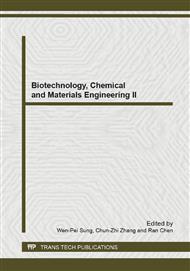p.97
p.101
p.105
p.109
p.113
p.117
p.123
p.128
p.132
Contrast Studies of Ultrasonic Degradation Rhodamine B and Methyl Orange Dynamics
Abstract:
The study compared rhodamine B and methyl orange aqueous solution of sonochemical degradation kinetics, the influence of ultrasonic power, initial concentration, operating temperature on reaction rate. The experiment show that degradation reaction is free radical oxidation organic matter generated by ultrasonic cavitation, rhodamine B and methyl orange initial concentration of 0.5×10-5- 4.0×10-5 mol/L, operating temperature of 25°C - 55°C, when ultrasonic frequency of 19.6 kHz, ultrasonic power of 170-260 W. sonochemical reaction of rhodamine B and methyl orange are in line with first order reaction kinetics, and sonochemical reaction rate constant increased with increase of ultrasonic power, with increase of initial concentration decreases, the lower operating temperature; under the same experimental conditions, the rate of chemical reaction of rhodamine B sound greater than the rate of sonochemical reaction of methyl orange.
Info:
Periodical:
Pages:
113-116
Citation:
Online since:
January 2013
Authors:
Keywords:
Price:
Сopyright:
© 2013 Trans Tech Publications Ltd. All Rights Reserved
Share:
Citation:


